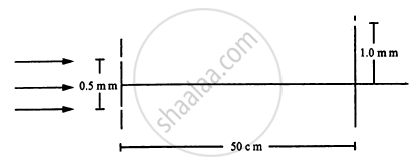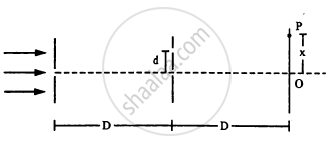Advertisements
Advertisements
प्रश्न
White coherent light (400 nm-700 nm) is sent through the slits of a Young's double slit experiment (see the following figure). The separation between the slits is 0⋅5 mm and the screen is 50 cm away from the slits. There is a hole in the screen at a point 1⋅0 mm away (along the width of the fringes) from the central line. (a) Which wavelength(s) will be absent in the light coming from the hole? (b) Which wavelength(s) will have a strong intensity?

उत्तर
Given:-
Separation between two slits,
\[d = 0 . 5 mm = 0 . 5 \times {10}^{- 3} m\]
Wavelength of the light,
\[\lambda = 400\text{ nm to 700 nm}\]
Distance of the screen from the slit,
\[D = 50 cm = 0 . 5 m\]
Position of hole on the screen,
\[y_n = 1 mm = 1 \times {10}^{- 3} m\]
(a) The wavelength(s) will be absent in the light coming from the hole, which will form a dark fringe at the position of hole.
\[y_n = \frac{\left( 2n + 1 \right) \lambda_n}{2}\frac{D}{d}\text{, where n = 0, 1, 2, ......}\]
\[\Rightarrow \lambda_n = \frac{2}{\left( 2n + 1 \right)} \frac{y_n d}{D}\]
\[= \frac{2}{\left( 2n + 1 \right)} \times \frac{{10}^{- 3} \times 0 . 05 \times {10}^{- 3}}{0 . 5}\]
\[= \frac{2}{\left( 2n + 1 \right)} \times {10}^{- 6} m\]
\[= \frac{2}{\left( 2n + 1 \right)} \times {10}^3 nm\]
For n = 1,
\[ \lambda_1 = \left( \frac{2}{3} \right) \times 1000 = 667 nm\]
For n = 2,
\[ \lambda_2 = \left( \frac{2}{5} \right) \times 1000 = 400 nm\]
Thus, the light waves of wavelength 400 nm and 667 nm will be absent from the light coming from the hole.
(b) The wavelength(s) will have a strong intensity, which will form a bright fringe at the position of the hole.
So, \[y_n = n \lambda_n \frac{D}{d}\]
\[ \Rightarrow \lambda_n = y_n \frac{d}{nD}\]
For n = 1,
\[ \lambda_1 = y_n \frac{d}{D}\]
\[ = {10}^{- 3} \times \left( 0 . 5 \right) \times \frac{{10}^{- 3}}{0 . 5}\]
\[ = {10}^{- 6} m = 1000 nm.\]
But 1000 nm does not fall in the range 400 nm to 700 nm.
Again, for n = 2,
\[ \lambda_2 = y_n \frac{d}{2D} = 500 nm\]
So, the light of wavelength 500 nm will have strong intensity.
APPEARS IN
संबंधित प्रश्न
Derive an expression for path difference in Young’s double slit experiment and obtain the conditions for constructive and destructive interference at a point on the screen.
The intensity at the central maxima in Young’s double slit experiment is I0. Find out the intensity at a point where the path difference is` lambda/6,lambda/4 and lambda/3.`
What is the effect on the fringe width if the distance between the slits is reduced keeping other parameters same?
In Young’s experiment, the ratio of intensity at the maxima and minima in an interference
pattern is 36 : 9. What will be the ratio of the intensities of two interfering waves?
Explain two features to distinguish between the interference pattern in Young's double slit experiment with the diffraction pattern obtained due to a single slit.
In Young’s double slit experiment to produce interference pattern, obtain the conditions for constructive and destructive interference. Hence deduce the expression for the fringe width.
In Young’s experiment interference bands were produced on a screen placed at 150 cm from two slits, 0.15 mm apart and illuminated by the light of wavelength 6500 Å. Calculate the fringe width.
Two coherent sources of light having intensity ratio 81 : 1 produce interference fringes. Calculate the ratio of intensities at the maxima and minima in the interference pattern.
Find the angular separation between the consecutive bright fringes in a Young's double slit experiment with blue-green light of wavelength 500 nm. The separation between the slits is \[2 \cdot 0 \times {10}^{- 3}m.\]
A plate of thickness t made of a material of refractive index µ is placed in front of one of the slits in a double slit experiment. (a) Find the change in the optical path due to introduction of the plate. (b) What should be the minimum thickness t which will make the intensity at the centre of the fringe pattern zero? Wavelength of the light used is \[\lambda.\] Neglect any absorption of light in the plate.
Two transparent slabs having equal thickness but different refractive indices µ1 and µ2are pasted side by side to form a composite slab. This slab is placed just after the double slit in a Young's experiment so that the light from one slit goes through one material and the light from the other slit goes through the other material. What should be the minimum thickness of the slab so that there is a minimum at the point P0 which is equidistant from the slits?
A Young's double slit apparatus has slits separated by 0⋅28 mm and a screen 48 cm away from the slits. The whole apparatus is immersed in water and the slits are illuminated by red light \[\left( \lambda = 700\text{ nm in vacuum} \right).\] Find the fringe-width of the pattern formed on the screen.
Consider the arrangement shown in the figure. The distance D is large compared to the separation d between the slits.
- Find the minimum value of d so that there is a dark fringe at O.
- Suppose d has this value. Find the distance x at which the next bright fringe is formed.
- Find the fringe-width.

In Young’s double-slit experiment, using monochromatic light, fringes are obtained on a screen placed at some distance from the slits. If the screen is moved by 5 x 10-2 m towards the slits, the change in the fringe width is 3 x 10-5 m. If the distance between the two slits is 10-3 m, calculate the wavelength of the light used.
In Young's double slit experiment shown in figure S1 and S2 are coherent sources and S is the screen having a hole at a point 1.0 mm away from the central line. White light (400 to 700 nm) is sent through the slits. Which wavelength passing through the hole has strong intensity?

In a double-slit experiment with monochromatic light, fringes are obtained on a screen placed at some distance from the plane of slits. If the screen is moved by 5 × 10-2 m towards the slits, the change in fringe width is 3 × 10-3 cm. If the distance between the slits is 1 mm, then the wavelength of the light will be ______ nm.
The central fringe of the interference pattern produced by the light of wavelength 6000 Å is found to shift to the position of the fourth bright fringe after a glass plate of refractive index 1.5 is introduced in the path of one of the beams. The thickness of the glass plate would be ______.
The maximum number of possible interference maxima for slit-separation equal to twice the wavelength in Young's double-slit experiment is ______.
In Young's double-slit experiment, the separation between the two slits is d and the distance of the screen from the slits is 1000 d. If the first minima fall at a distance d from the central maximum, obtain the relation between d and λ.
